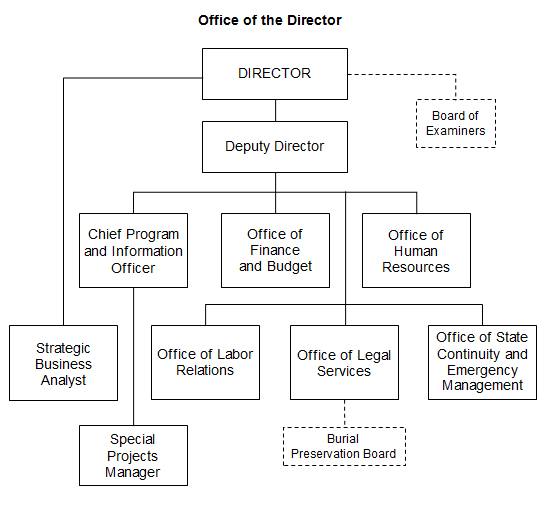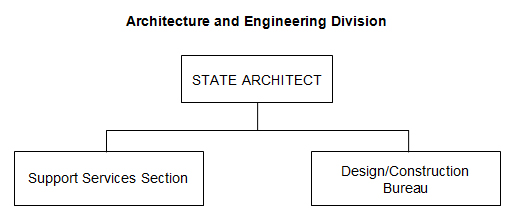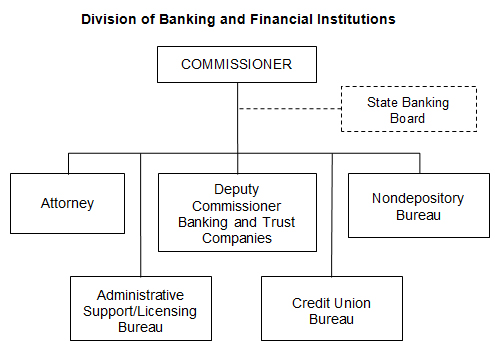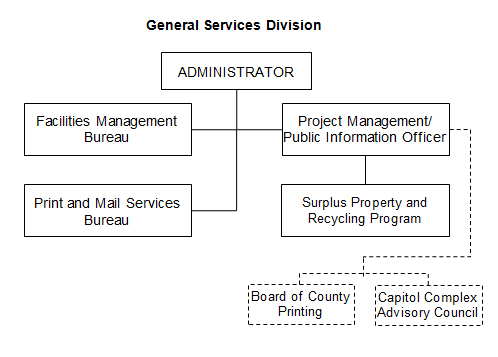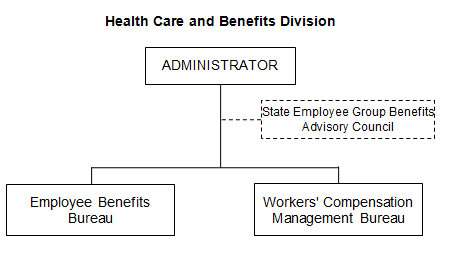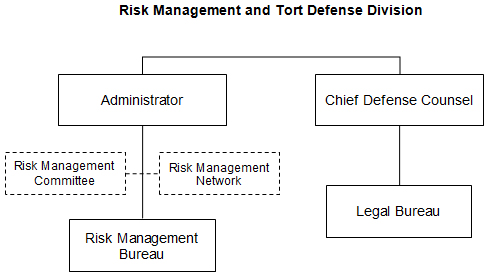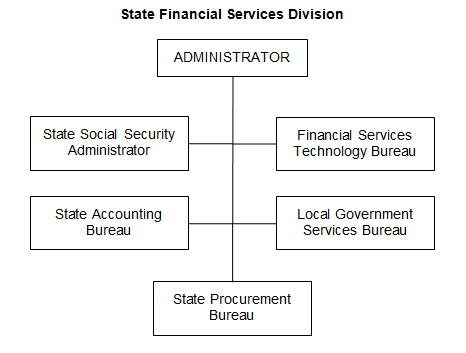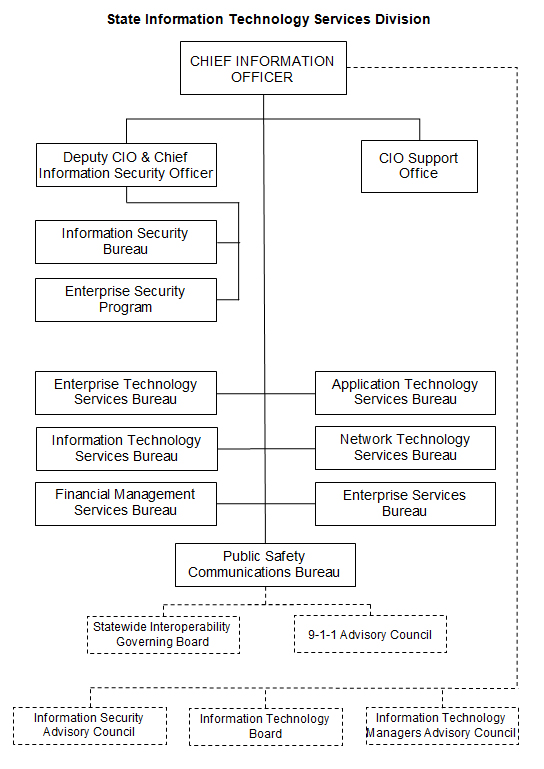
| HOME | SEARCH | ABOUT US | CONTACT US | HELP | ||
| |
| Prev | Next |
|
2.1.101 ORGANIZATIONAL RULE (1) The organization and functions of the Department of Administration and its attached agencies are described in this rule. (a) History. The department was originally established under the Office of the State Controller by Chapter 271, Session Laws of 1963, and was reestablished under the Executive Reorganization Act of 1971. (b) Director. The director of the Department of Administration is appointed by the Governor and is responsible for managing the department and its divisions. The director is supported by a deputy director, a chief program and information officer, a strategic business analyst, and the offices of Finance and Budget, Human Resources, Labor Relations, Legal Services, and State Continuity and Emergency Management. (c) Divisions. The department consists of the following eight divisions: (i) Architecture and Engineering Division; (ii) Division of Banking and Financial Institutions; (iii) General Services Division; (iv) Health Care and Benefits Division; (v) Risk Management and Tort Defense Division; (vi) State Financial Services Division; (vii) State Human Resources Division; and (viii) State Information Technology Services Division. (2) Functions of the Department Divisions. (a) Architecture and Engineering Division. The Architecture and Engineering Division manages remodeling and construction of state buildings. Its functions include overseeing the architect/engineer interview and selection process; planning both new and remodel projects; administering and coordinating plan reviews; negotiating and administering contracts with architects and engineers; advertising, bidding, awarding, and administering construction contracts; disbursing building construction payments; providing design services for small projects; and formulating a long-range building plan for legislative consideration each session. (b) Division of Banking and Financial Institutions Division. The Division of Banking and Financial Institutions is responsible for the supervision, regulation, and examination of state-chartered banks, trust companies, savings and loans, credit unions, consumer loan and sales finance companies, deferred deposit lenders, title loan companies, escrow companies, mortgage brokers and loan originators, and mortgage lenders. The purpose of the supervisory function of banks and credit unions is to investigate the methods of operation and determine whether these institutions are operating in a safe and sound manner. The nondepository financial institutions and licensees are examined for compliance with federal and state law. Supervision of financial institutions is accomplished through examinations conducted by division examiners. (c) General Services Division. The General Services Division, composed of two bureaus and a business support services unit, is responsible for providing certain internal services to government agencies and the public. The Facilities Management Bureau manages the following services for state agencies in the Capitol Complex and state-owned buildings in the Helena area, either directly or through the administration of service contracts: repair, maintenance, construction, energy consumption, emergency response, space allocation, lease negotiation, facility security, janitorial, pest control, grounds maintenance, and garbage collection. The Print and Mail Services Bureau provides printing services to state agencies by operating a central facility for duplicating and binding, desktop publishing, layout and design, graphic illustration, and forms design. The bureau operates a quick copy center, administers the state photocopy pool, and manages procurement of all printing and printing-related purchases for state agencies. Mail services for state agencies in the Helena area are provided through a centralized facility that manages incoming, outgoing, and interagency mail. In addition, the bureau operates a full-service contract U.S. Post Office in the State Capitol. The Surplus Property and Recycling Program promotes sustainable use of state-owned property by providing access to surplus property for state and local governments and nonprofits, and recycling common items and materials on the Capitol Complex. (d) Health Care and Benefits Division. The Health Care and Benefits Division provides competitive, comprehensive benefits that provide financial protection for state employees, retirees, legislators, and their families. Benefit programs provided include group health, medical, long-term disability, vision, dental, life, long-term care, workers' compensation policy, safety, and return-to-work protection. In addition, the division provides wellness programs, sick leave fund, and medical case management for high-cost medical care, for all state employees. (e) Risk Management and Tort Defense Division. The Risk Management and Tort Defense Division promotes the development of risk management and loss prevention principles and techniques through consultation and training with state agencies and universities; serves as a resource in resolving risk management and tort liability defense issues for the protection of state assets and resources; purchases and maintains a comprehensive insurance plan on behalf of state agencies; seeks timely and cost-effective resolution of all property and casualty claims filed against the state; and provides legal assistance to state defendants through the use of staff counsel, agency legal services counsel, or contract counsel. The Risk Management Committee is composed of representatives from all state agencies. The committee is charged with assisting state agencies in managing their loss prevention, insurance, and claims activities. The Risk Management Network, composed of state and private representatives, provides feedback and recommendations to the Risk Management and Tort Defense Division on the implementation and management of the state's loss prevention, insurance, and claims programs. (f) State Financial Services Division. The State Financial Services Division is responsible for providing accounting and procurement services and guidance to all state agencies; serving as the central banking function for agencies; supporting the financial and budgeting modules of the Statewide Accounting, Budgeting, and Human Resource System (SABHRS); assisting local governments with financial reporting and audit review statutory compliance; and administering the Social Security Act Section 218 program for the state. The State Accounting Bureau is the process owner of the SABHRS financial modules and provides technical assistance to agencies. The bureau prepares and publishes the state's comprehensive annual financial report (CAFR), develops the state's accounting policies and procedures, and provides technical accounting assistance to agencies. The Warrant Writer Unit manages the state payment processes, maintains the state vendor file, and issues 1099 miscellaneous forms. The Treasury Unit is responsible for maintaining accountability of all money and securities belonging to or held in trust by the state. The Financial Services Technology Bureau is responsible for the operational support and maintenance of the enterprise financial and budget development information systems in SABHRS. The bureau works in partnership with the State Accounting Bureau, Office of Budget and Program Planning, Legislative Fiscal Division, and the State Human Resources Division. The CAFR, budget books, single audit reports, and agency financial schedules rely on the financial information housed in SABHRS. The State Procurement Bureau procures or supervises the procurement of all supplies and services needed by the state, to ensure compliance with the Montana Procurement Act. The bureau maintains the Montana Acquisition and Contracting System (eMACS) and provides technical assistance to government agencies and the public. In addition, the bureau manages the state's vehicle fueling system, energy procurement, and all procurement card functions. The Local Government Services Bureau is responsible for administering provisions of the Montana Single Audit Act and providing technical accounting, budgeting, financial reporting, and audit compliance assistance to local governments. The bureau maintains and publishes the local government Budgetary, Accounting, and Reporting System (BARS) chart of accounts as well as the county collection and accounting manuals. The bureau also receives and makes local government financial, budget, and audit reports available to the public. The State Social Security Administrator is responsible for administering Section 218 of the Social Security Act, including interpreting its provisions, providing education and outreach, and ensuring proper application of Social Security coverage to all state and local government employees. (g) State Human Resources Division. The State Human Resources Division provides state agencies with a variety of human resource management services including professional development, salary administration, policy development, workforce planning, payroll and benefit eligibility administration, and an employee assistance program. The State Human Resources Division is the process owner of the SABHRS human capital management modules. In addition, the division provides support for the following two groups. The State Employees' Charitable Giving Campaign Advisory Council, (SECGC) appointed by the director, advises the department on the SECGC's activities and implements the annual campaign plan. The council consists of state employee representatives and representatives from a statewide federation, a local federation, and an independent nonprofit organization. The Interagency Committee for Change by Women (ICCW) was created by executive order "to create positive change for all state employees by promoting the full participation of women in state government." State agency directors appoint representatives to the committee. (h) State Information Technology Services Division. The State Information Technology Services Division, composed of eight bureaus and two offices, is responsible for the delivery of information technology (IT) services and the planning, coordination, implementation, operation, and control of information resources throughout state government. Information services and resources include computing and storage systems, telecommunication systems (including telephone systems, local area networks, wide area networks, high-speed voice, video, and data backbone network infrastructure, and interactive video systems), desktop office products and systems, Internet and application systems and capabilities, management of the statewide emergency 9-1-1 system, and enterprise security services. The division provides oversight for IT planning and policy development throughout the state, and coordination of agency information technology budget requests with the Office of Budget and Program Planning. The Information Technology Managers Advisory Council consists of IT managers representing state agencies in the executive, legislative, and judicial branches, the university system, and local government. The council reviews enterprise IT issues; provides feedback regarding information management policies; reviews opportunities for the application of new information processing technology; and participates in statewide IT planning efforts. (3) Attached Boards, Commissions, and Councils. The following boards, commissions, and councils are allocated to the department for administrative purposes: (a) Board of County Printing. The Board of County Printing, established under 2-15-1026, MCA, consists of five members appointed by the Governor with the consent of the Montana Senate. The board's purpose is to adopt and publish a schedule of maximum prices to be charged for county legal advertising and to establish printing standards for county legal advertising. Rules regarding the board are set out in ARM Title 2, Chapter 67. (b) Board of Examiners. The Board of Examiners (2-15-1007, MCA) consists of the Governor, Secretary of State, and Attorney General. The board is authorized to prescribe the form and terms of the sale of bonds for the state and take whatever actions are lawful and necessary for their issuance and payment. Board rules are set out in Chapter 53. (c) Burial Preservation Board. The Burial Preservation Board, established under 22-3-804, MCA, consists of 13 members appointed by the Governor. The purpose of the board is to help protect from disturbance or destruction all human skeletal remains, burial sites, and burial material within the state of Montana. Rules regarding the board, including the board's organization, are set out in Chapter 65. (d) Information Technology Board. The Information Technology Board, established by 2-15-1021, MCA, consists of 19 appointed members who help guide state agencies, the legislative branch, the judicial branch, and local governments in the development and deployment of intergovernmental information technology resources. The board also advises the department on statewide information technology standards and policies, the state strategic information technology plan, major information technology budget requests, and rates and other charges for services established by the department. (e) Montana Tax Appeal Board. The Montana Tax Appeal Board (15-2-102, MCA) is composed of three members appointed by the Governor for staggered six-year terms, with the advice and consent of the Montana Senate. The board hears appeals on the decisions of local county tax appeal boards concerning property tax assessments made by the state Department of Revenue and takes original jurisdiction on appeals arising from decisions of the Department of Revenue concerning income, corporate, natural resource, centrally assessed property, and new industry taxes; from decisions of the Department of Transportation concerning motor fuels taxes; and from decisions of the Department of Justice concerning the valuation of motor vehicles. Board rules are set forth in Chapter 51. (f) Public Employees' Retirement Board. The Public Employees' Retirement Board, established under 2-15-1009, MCA, is composed of seven members appointed by the Governor. The board establishes policies that provide employees of the state and its political subdivisions with quality retirement, disability, and death benefits. The board also conducts hearings and adjudicates contested cases. Board-administered retirement systems cover traditional public employees, judges, and public safety officers, but generally exclude teachers. The Montana Public Employee Retirement Administration, an agency of state government, is responsible for the day-to-day administration of the retirement systems. The board's rules are found in Chapter 43. (g) State Banking Board. The State Banking Board, established under 2-15-1025, MCA, consists of six members appointed by the Governor to advise the Department of Administration regarding banking in Montana. Chapter 60 houses the board's rules. (h) State Compensation Insurance Fund Board. The Board of Directors of State Compensation Insurance Fund consists of seven members appointed by the Governor to govern the State Fund, a workers' compensation insurer which is a nonprofit independent public corporation. The organization of the State Compensation Insurance Fund, established under 2-15-1019, MCA, and additional rules are set out in Chapter 55. (i) Teachers' Retirement Board. The Teachers' Retirement Board (2-15-1010, MCA) is composed of six members appointed by the Governor. The board provides a comprehensive retirement plan for all members of the state Teachers' Retirement System. This includes offering the broadest and fairest possible range of disability, death, and retirement benefits to qualified members. The Teachers' Retirement Board maintains an office of state government entitled the "Teachers' Retirement System." Additional rules are set out in Chapter 44. (j) State Lottery Commission. The State Lottery Commission (23-7-201, MCA) consists of five members appointed by the Governor to establish and operate a state lottery. The organizational structure and additional rules regarding the Montana Lottery are set out in Chapter 63. (k) Capitol Complex Advisory Council. The council, made up of nine individuals representing various state agencies, the Legislature, and the public, advises the Legislature on the placement of commemorative objects and art in public areas of the Capitol Complex and grounds, including the executive residence and the Original Governor's Mansion; and advises the Department of Administration on interior decoration of the Capitol, grounds maintenance, and grounds displays. (l) Montana Information Security Advisory Council. The Information Security Advisory Council, created by executive order, advises the Governor with respect to a statewide strategic information security program. (m) State Employee Group Benefits Advisory Council. The State Employee Group Benefits Advisory Council members are selected by the department director from a diverse group representing state employees and retirees. The council, established by 2-15-1016, MCA, advises the department regarding state employee group benefit plans managed by the Health Care and Benefits Division. (4) Information or Submissions. General inquiries regarding the department may be addressed to the director. Specific inquiries regarding the functions of each division or attached agency may be addressed to the head of that division and/or agency. All requests for hearings, declaratory rulings, and for participation in rulemaking may be addressed to the director unless the notice in the Montana Administrative Register makes specific provisions for submissions. (5) Personnel Roster. Addresses of the director, each division, and attached agencies are as follows: Director, Department of Administration, Room 155, Mitchell Building, 125 North Roberts Street, P.O. Box 200101, Helena, MT 59620-0101. Architecture and Engineering Division, 1520 East Sixth Avenue, P.O. Box 200103, Helena, MT 59620-0103. Division of Banking and Financial Institutions, 301 South Park Avenue, Suite 316, P.O. Box 200546, Helena, MT 59620-0546. General Services Division, 1310 East Lockey Avenue, Old Livestock Building, P.O. Box 200110, Helena, MT 59620-0110. Health Care and Benefits Division, 100 North Park Avenue, Suite 320, P.O. Box 200130, Helena, MT 59620-0130. Risk Management and Tort Defense Division, 1625 Eleventh Avenue, Middle Floor, P.O. Box 200124, Helena, MT 59620-0124. State Accounting Division, Room 255, Mitchell Building, 125 North Roberts Street, P.O. Box 200102, Helena, MT 59620-0102. State Human Resources Division, Room 125, Mitchell Building, 125 North Roberts Street, P.O. Box 200127, Helena, MT 59620-0127. State Information Technology Services Division, Room 229, Mitchell Building, 125 North Roberts Street, P.O. Box 200113, Helena, MT 59620-0113. Montana Lottery, 2525 North Montana Avenue, Helena, MT 59601-0598. Montana State Fund, 855 Front Street, Helena, MT 59601. Office of the State Public Defender, 44 West Park Street, Butte, MT 59701. Public Employee Retirement Administration, 100 North Park Avenue, Suite 200, P.O. Box 200131, Helena, MT 59620-0131. Montana Tax Appeal Board, 600 North Park Avenue, P.O. Box 200138, Helena, MT 59620-0138. Teachers' Retirement System, 1500 Sixth Avenue, P.O. Box 200139, Helena, MT 59620-0139. (6) Charts of Agency Organization. Organizational charts of the Department of Administration are attached on the following pages and are incorporated into this rule.
History: 2-4-201, MCA; IMP, 2-4-201, MCA; Eff. 12/31/72; AMD, Eff. 11/15/76; AMD, Eff. 8/7/79; AMD, Eff. 12/31/81; AMD, Eff. 9/30/88; AMD, Eff. 12/31/88; AMD, Eff. 9/30/90; AMD, Eff. 7/1/01; AMD, Eff. 11/1/01; AMD, Eff. 6/30/08; AMD, Eff. 6/30/09; AMD, Eff. 12/31/10; AMD, Eff. 5/1/13; AMD, Eff. 9/20/13; AMD, Eff. 9/1/15; AMD, Eff. 8/1/21. | ||||
A directory of state agencies is available online at http://www.mt.gov/govt/agencylisting.asp.
For questions about the organization of the ARM or this web site, contact [email protected].
